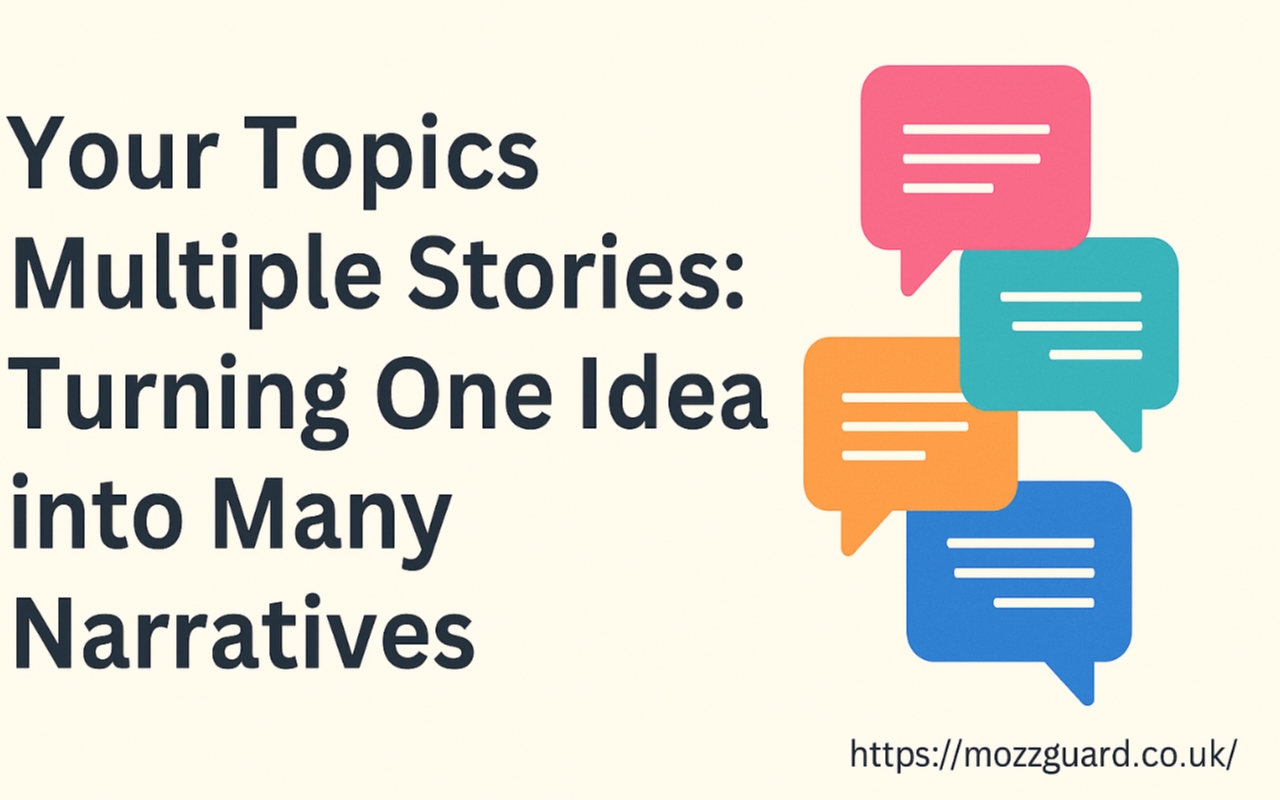Introduction: The Power of Storytelling in Modern Communication
In an age where content is king and attention is fleeting, storytelling has emerged as one of the most powerful tools in the communicator’s arsenal. Stories capture attention, engage the imagination, and make ideas memorable. But what happens when you blend storytelling with strategic content creation? The result is a method known as “Your Topics Multiple Stories,” a technique that allows you to take one central idea and explore it from multiple angles through storytelling. This method not only increases the depth of your content but also its relatability and reach. In this article, we’ll explore how you can effectively apply this technique to enrich your content, engage diverse audiences, and amplify your message across various platforms.
What Does “Your Topics Multiple Stories” Mean?
At its core, “Your Topics Multiple Stories” refers to the strategy of taking one overarching topic and illustrating it through a variety of narratives. Instead of focusing on a single storyline or case study, this method involves incorporating several stories—each offering a unique perspective, context, or lesson—to explore the topic more comprehensively. This technique can be especially valuable in educational content, marketing, blogging, and even academic writing. The result is content that feels more dynamic, inclusive, and authentic, encouraging a deeper connection with your audience.
Why Use Multiple Stories for One Topic?
Using multiple stories to explain or support one topic serves several purposes. Firstly, it acknowledges the complexity of most subjects. Rarely can one story capture all facets of an idea. Secondly, it caters to a diverse audience. What resonates with one person may not resonate with another, so providing varied narratives increases the chances of connection. Thirdly, it helps reinforce key points through repetition and variation. Each story serves as a new lens, reinforcing the central theme while adding new dimensions to it.
Additionally, using multiple stories helps in breaking down abstract or complex ideas into relatable, digestible parts. Whether you’re discussing leadership, innovation, personal development, or social issues, multiple stories can humanize the topic and make it easier for your audience to understand and relate to.
The Psychological Impact of Stories in Content
Stories appeal to our emotions and cognitive biases. Research in neuroscience and psychology shows that stories activate more areas of the brain than simple facts or data. When you hear a story, your brain releases oxytocin, a chemical that fosters empathy and bonding. This makes your message more memorable and persuasive. By using multiple stories in your content, you are essentially giving your audience several opportunities to engage emotionally with your topic. Each story adds a new layer of emotional and cognitive engagement, increasing the overall impact of your message.
Moreover, stories create patterns that the human brain naturally seeks. When multiple stories are used effectively, they form a thematic network that helps audiences understand and retain information better. For content creators, this means longer time on page, more shares, and a stronger connection with readers.
How to Choose the Right Stories for Your Topic
Selecting the right stories for your topic is crucial. Not all stories will enhance your content; some may distract or confuse your audience. Begin by identifying the key message or insight you want to convey. Then, brainstorm different scenarios, case studies, or personal anecdotes that align with that message. Aim for diversity—not just in terms of the people or settings involved, but also in the emotional tone and perspective.
For example, if your topic is about resilience, you could include a story of a war veteran, a cancer survivor, a failed entrepreneur who bounced back, and a student who overcame academic struggles. Each story touches on the same theme but brings unique nuances to it. Make sure each story contributes something specific to the understanding of the topic, and be mindful of your audience’s cultural and emotional sensibilities.
Structuring Content with Multiple Stories
One of the challenges in using multiple stories is maintaining coherence. A scattered collection of anecdotes can overwhelm or confuse your readers. To avoid this, use a clear structure. Start with an introduction that outlines the central theme. Then, use subheadings to introduce each story, making sure each one links back to the main topic. After presenting your stories, include a synthesis or conclusion that ties them all together, reinforcing your key takeaways.
Here’s a sample structure:
- Introduction: Present the central idea.
- Story 1: Show one facet of the idea.
- Story 2: Provide a contrasting or complementary angle.
- Story 3: Add a broader or more personal context.
- Synthesis: Compare and contrast the stories.
- Conclusion: Reinforce the central theme and implications.
This structure ensures that your content flows logically and that your audience can follow and absorb the information effectively.
Examples of “Your Topics Multiple Stories” in Different Fields
This technique can be applied across various domains:
In Education:
A lesson on climate change can be enriched with stories of a scientist researching in Antarctica, a farmer dealing with drought, and a student leading a school recycling program. Each story highlights a different aspect of the issue.
In Business:
A post on customer service could include stories from a small business owner, a customer complaint gone viral, and a customer service rep who turned an angry client into a brand advocate. These stories illustrate the multi-faceted nature of customer experience.
In Personal Development:
An article on mindfulness could feature a story of a corporate executive who found balance through meditation, a stay-at-home parent using mindfulness to manage stress, and a teenager coping with anxiety through mindful breathing. These diverse stories make the concept more accessible.
In Marketing:
A campaign about innovation might share stories of historical inventors, modern tech startups, and community-driven grassroots innovations. Each story adds credibility and relevance.
The SEO Advantage of Using Multiple Stories
From an SEO perspective, using multiple stories can enhance keyword diversity, user engagement, and content length—all of which contribute to better search engine rankings. Stories naturally incorporate related keywords and phrases, reducing the need for forced optimization. They also keep users on your page longer and increase the likelihood of shares and backlinks. Additionally, well-structured long-form content with rich storytelling often earns higher rankings in search results because it signals value and authority to search engines.
Moreover, Google’s algorithms are increasingly prioritizing user experience, which includes factors like engagement and relevance. A compelling story—or better yet, multiple stories—can significantly improve both metrics.
Tips for Writing Better Multi-Story Content
- Be Authentic: Real, relatable stories resonate better than overly polished or exaggerated ones.
- Use Dialogue and Detail: Bring your stories to life with sensory details and conversations.
- Maintain Balance: Ensure each story gets enough space and relevance.
- Stay Focused: Tie every story back to your main point.
- Edit Ruthlessly: Remove anything that doesn’t serve the central theme.
- Use Visuals: Images, infographics, and even videos can complement your stories and add depth.
Conclusion: Harnessing the Power of Your Topics Multiple Stories
The technique of “Your Topics Multiple Stories” is more than just a content strategy—it’s a way of thinking about communication. By approaching a topic from multiple angles, you offer your audience a richer, more inclusive experience. You cater to different learning styles, emotional triggers, and cognitive frameworks. Whether you’re a blogger, educator, marketer, or thought leader, embracing this method can elevate your content and deepen your impact.
In a world overflowing with information, it’s the stories we remember—and when one topic carries many stories, it becomes more than just content. It becomes a narrative journey that your audience won’t forget.
Read more: Ashcroft Capital Lawsuit: What Investors Need to Know



